It’s challenging to fully capture the experience of spending days hiking through Wyoming’s Wind River Range with words alone. Standard superlatives feel inadequate for describing the relentless spectacle of sharp, granite peaks soaring over 13,000 feet, mirrored in thousands of pristine alpine lakes. However, one truth I’ve learned from numerous personal trips and assisting many others in planning their journeys there is this: Backpackers who explore the Winds invariably leave feeling they have discovered a truly special place. They are often compelled to return, time and time again.
Having had the privilege of backpacking across the United States for nearly four decades, including a decade as the Northwest Editor for Backpacker magazine and even longer running my own outdoor blog, I confidently rank the Winds among “America’s Top 10 Best Backpacking Trips.” In a very real sense, I am perpetually planning my next adventure in this remarkable range. Planning a trip focused on Backpacking Wyoming Wind River Range guarantees an encounter with unparalleled natural beauty and challenging trails.
The options for exceptional multi-day hikes are virtually limitless within a range that spans 100 miles along the Continental Divide. It boasts over 1,300 named lakes (and easily double that number in total) and encompasses more than two million acres—an area nearly identical in size to its more famous northern neighbor, Yellowstone National Park. Several campsites I’ve used in the Winds feature on my list of 25 all-time favorite backcountry sites, and honestly, almost any camp here could make any backpacker’s favorite list. Many days spent hiking in the Winds also rank among my most scenic days of hiking ever.
Searching for solitude? With some effort and thoughtful planning, you can certainly find it. I have frequently backpacked into areas of the Wind River Range, both on and off-trail, and reached places where we would encounter only a handful of other people daily. Sometimes, this solitude was just a day’s walk from a popular trailhead, proving that Backpacking Wyoming Wind River Range offers experiences for every preference.
This guide outlines ten different backpacking trips throughout the Wind River Range. These are routes I have personally completed or are minor variations thereof. The accompanying photos often convey the story more powerfully than words alone. These trips take you through renowned and unique locations such as the Cirque of the Towers and Titcomb Basin, sections of the Continental Divide Trail, as well as trails and passes you might not have heard of previously.
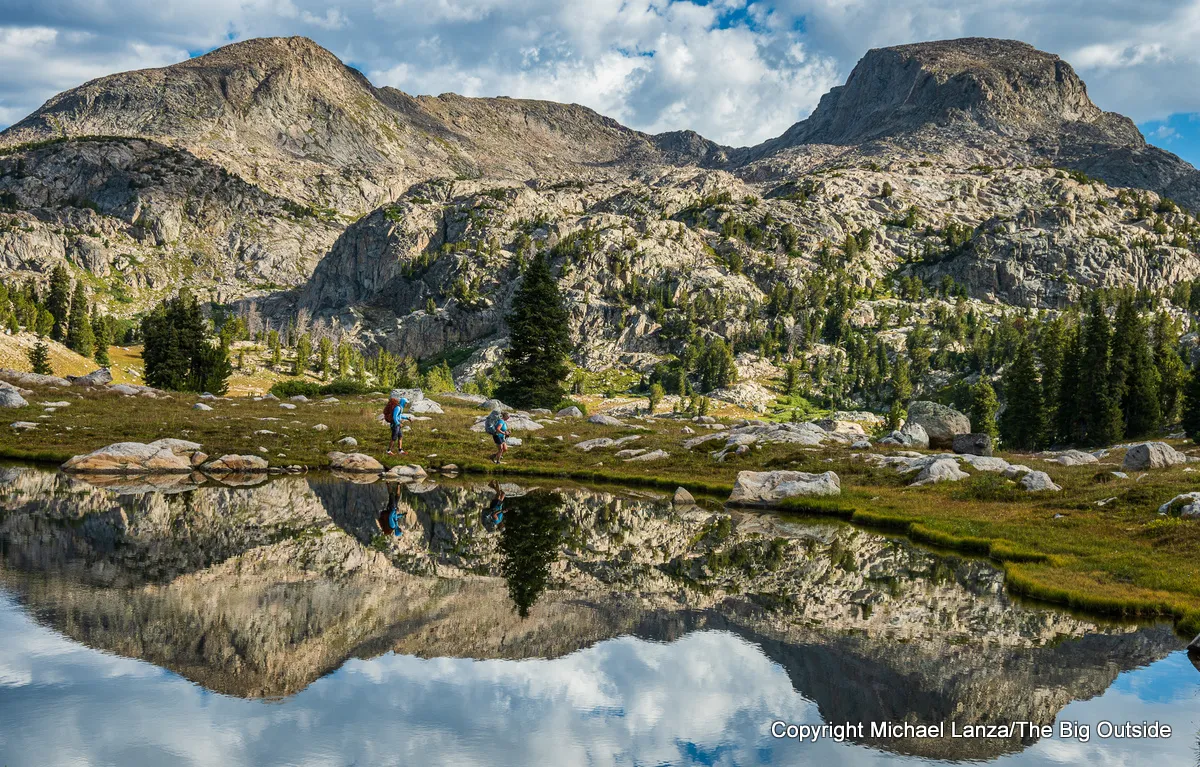 Backpackers hiking past a tarn off the Highline Trail (CDT) in WyomingBackpackers navigating a tarn near the Highline Trail (CDT) while Backpacking Wyoming Wind River Range.
Backpackers hiking past a tarn off the Highline Trail (CDT) in WyomingBackpackers navigating a tarn near the Highline Trail (CDT) while Backpacking Wyoming Wind River Range.
These trips vary in length, ranging from just under 30 miles to nearly 100 miles. Most fall within the sweet spot for many backpackers, around 30 to 45 miles. They span a difficulty spectrum from relatively beginner-friendly routes to serious adventures in remote wilderness areas. Many trails in the Winds sit between 10,000 and 11,000 feet in elevation, and passes typically climb to nearly or well over 11,000 feet.
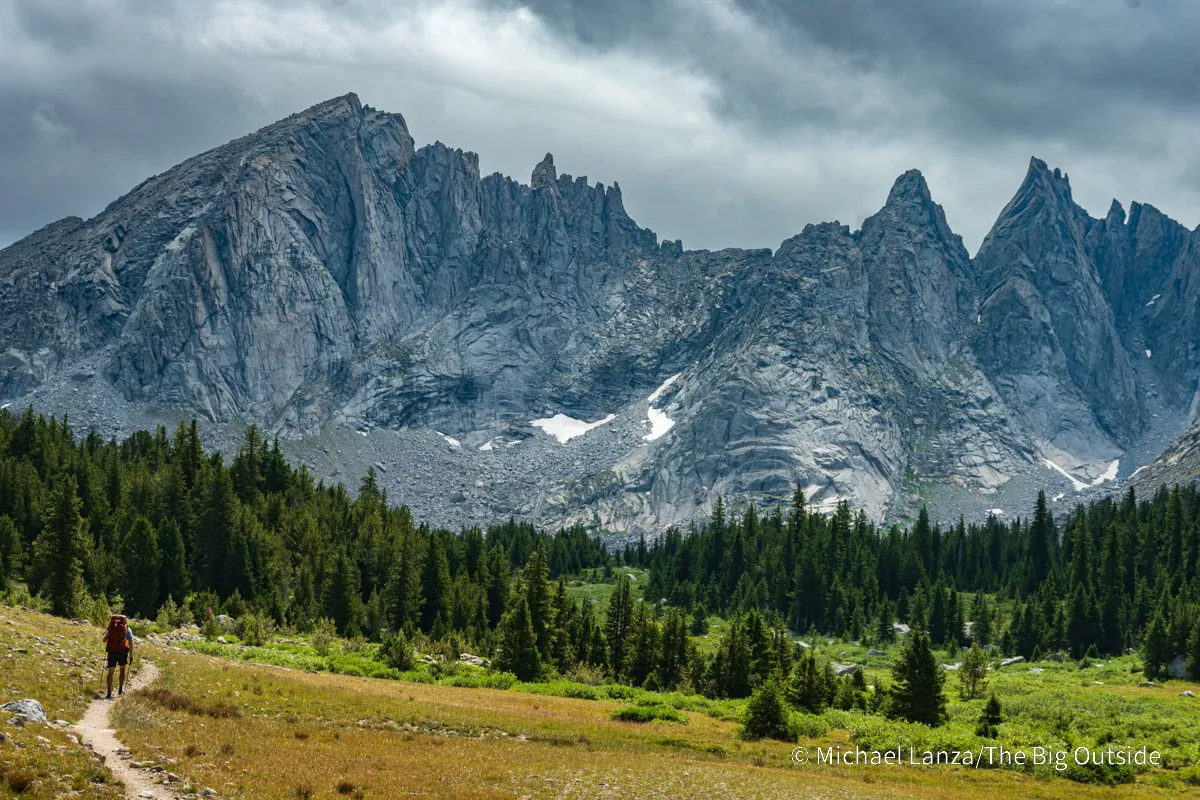 A backpacker hiking the Shadow Lake Trail in the Wind River Range, Wyoming.Hiking the Shadow Lake Trail exemplifies the stunning scenery found when Backpacking Wyoming Wind River Range.
A backpacker hiking the Shadow Lake Trail in the Wind River Range, Wyoming.Hiking the Shadow Lake Trail exemplifies the stunning scenery found when Backpacking Wyoming Wind River Range.
The Best Backpacking Trip in the Winds
Naming a single “best” backpacking trip in the Winds is a tough decision. However, after extensive exploration across the range, my choice is this 41-mile route starting from Big Sandy Campground. Scenery is breathtaking around every corner. The route crosses four high passes on the Continental Divide and meanders past an ongoing display of spectacular mountains and lakes perfect for camping beside.
The trip reaches its most dramatic point in the incredibly vertical landscape of the Cirque of the Towers. You will likely encounter other backpackers on the first and last days, especially in popular areas. However, abundant solitude is easily found; on one trip, a friend and I saw only six other backpackers on our second day, despite being just a day’s walk from a busy trailhead. The route also offers opportunities to extend the hike, exploring a stunning cirque or scrambling to the summit of a 12,000-foot peak.
Unlike the Wind River High Route, this trip offers a reasonable challenge and distance for most experienced backpackers. Note that camping is restricted within a half-mile radius of Lonesome Lake to protect the fragile area. This 41-mile journey is a prime example of exceptional Backpacking Wyoming Wind River Range.
See my story “The Best Backpacking Trip in the Wind River Range? Yup” and all stories about backpacking in the Winds at The Big Outside.
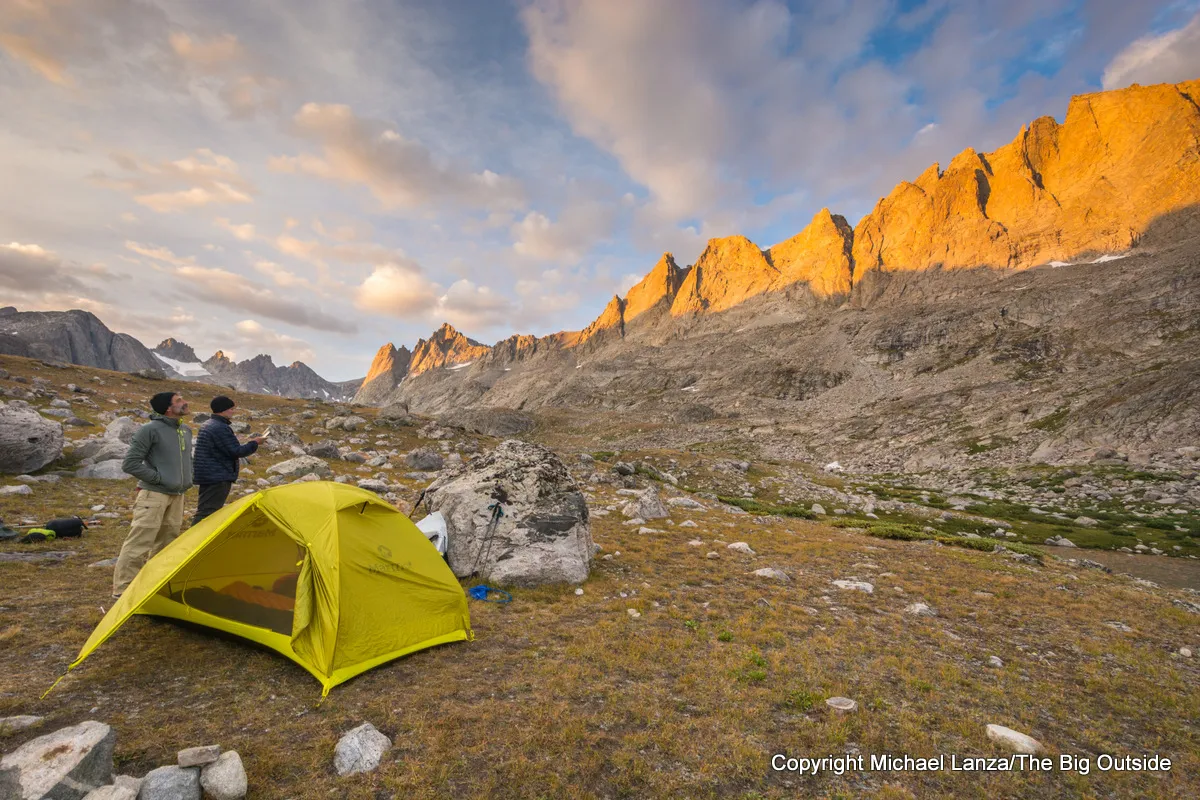 Backpackers watching sunset at a campsite in Titcomb Basin, Wind River Range, Wyoming.Enjoying alpenglow from a campsite in Titcomb Basin during a Backpacking Wyoming Wind River Range adventure.
Backpackers watching sunset at a campsite in Titcomb Basin, Wind River Range, Wyoming.Enjoying alpenglow from a campsite in Titcomb Basin during a Backpacking Wyoming Wind River Range adventure.
Titcomb and Indian Basins
After a full day’s hike to reach a campsite in a grassy meadow nestled between the two largest Titcomb Lakes, around 10,500 feet in Titcomb Basin, two friends and I witnessed the alpenglow illuminate the 13,000-foot peaks above us in golden light. On a separate expedition to Indian Basin, several of us successfully summitted a 12,000-foot peak and a pair of 13ers located on the Continental Divide: Fremont Peak and Jackson Peak.
These two impressive lake basins lie on the west and south sides of 13,745-foot Fremont Peak. Titcomb Basin sits at roughly 10,500 feet, while Indian Basin is higher, exceeding 11,000 feet. Camping near the lakes in either basin provides dramatic views looking up at the towering wall of peaks along the Divide.
Both Titcomb and Indian Basins can be accessed via an out-and-back hike of approximately 28 miles round-trip (reaching the middle of either basin) from the Pole Creek Trailhead at Elkhart Park, near Pinedale. They are only a few trail miles apart, making it possible to explore or even camp in both on a trip lasting two to four days. Backpacking to these basins is a highlight for many exploring the Wind River Range.
See my story “Best of the Wind River Range: Backpacking to Titcomb Basin.”
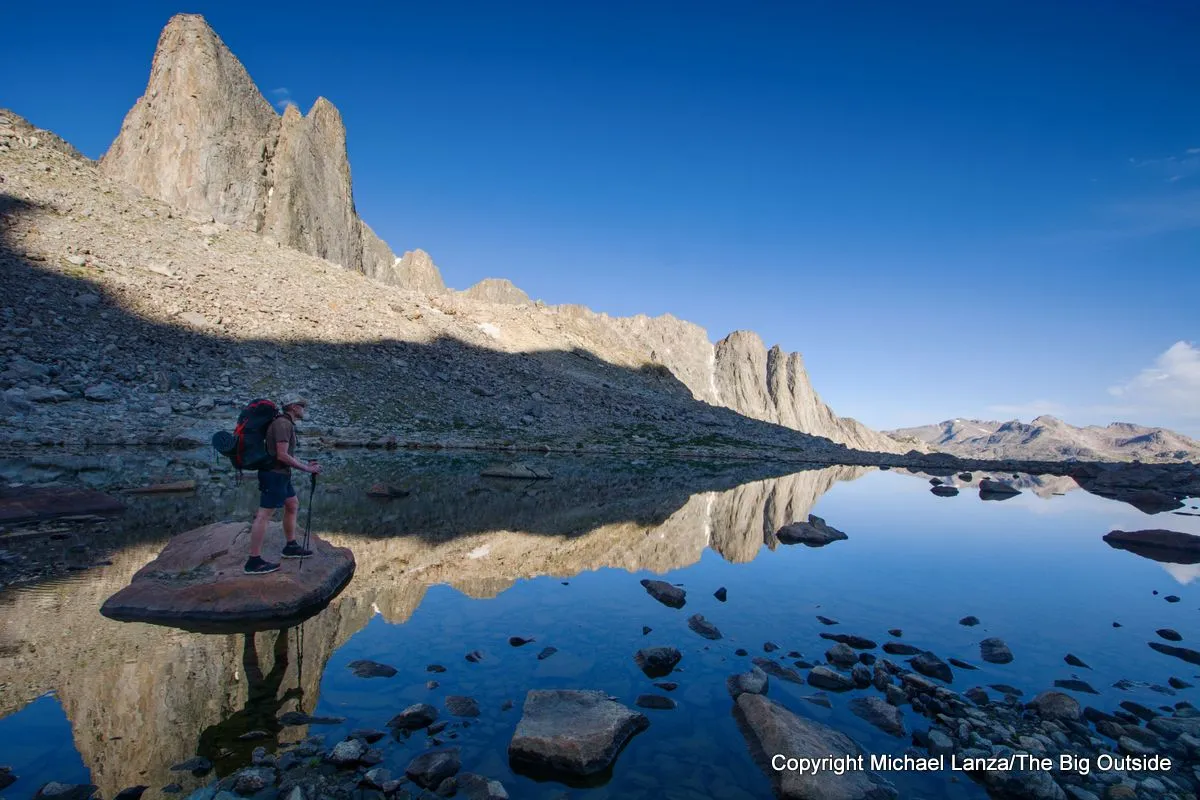 A backpacker at a small tarn in the upper valley of Middle Fork Lake on the Wind River High Route.A hiker pauses at a tarn high on the challenging Wind River High Route while Backpacking Wyoming Wind River Range.
A backpacker at a small tarn in the upper valley of Middle Fork Lake on the Wind River High Route.A hiker pauses at a tarn high on the challenging Wind River High Route while Backpacking Wyoming Wind River Range.
The Wind River High Route
This high-altitude traverse of the entire range arguably deserves the title of the best backpacking trip in the Winds. However, at 96 miles, with two-thirds of the route off-trail, it represents a significant challenge. The vast majority of this route is very difficult and presents serious hazards, including the threat of rockfall. It crosses ten named alpine passes ranging from nearly 11,000 to almost 13,000 feet, with only one of these passes located on a maintained trail. This high route simply lies beyond the skill set, stamina, and interest of 99 percent of backpackers.
For those with the necessary experience for a rugged, physically and mentally demanding, navigationally complex, high-intensity adventure, the Wind River High Route is arguably the most stunning trek, mile for mile, through any mountain range in America. While areas like the Cirque of the Towers and Titcomb Basin attract most backpacker attention, the WRHR traverses numerous virtually unknown high basins that are just as spectacular. As you might expect, solitude is guaranteed on this high-altitude journey, the ultimate test for Backpacking Wyoming Wind River Range enthusiasts.
What to Eat in Fort Worth – A Culinary Deep Dive
Discover the Top Restaurants in Denver – A Culinary Journey
Discover Where to Visit in Las Vegas
See my story “Adventure and Adversity on the Wind River High Route.”
 A backpacker above Macon Lake and Washakie Lake in the Wind River Range, Wyoming.Views overlooking high alpine lakes like Macon Lake and Washakie Lake are rewards of Backpacking Wyoming Wind River Range.
A backpacker above Macon Lake and Washakie Lake in the Wind River Range, Wyoming.Views overlooking high alpine lakes like Macon Lake and Washakie Lake are rewards of Backpacking Wyoming Wind River Range.
Hailey Pass-Washakie Pass Circuit
This 35-mile lollipop loop also starts from Big Sandy Campground and overlaps significantly with the 41-mile route I consider the “best backpacking trip in the Winds” (described above). Its key difference is that it bypasses the very steep, loose, unmaintained route over Texas Pass, thereby avoiding the section through the Cirque of the Towers. Instead, this circuit sticks entirely to maintained trails, crossing just two passes, both topping 11,000 feet: Hailey Pass and Washakie Pass.
This route visits numerous picturesque lakes, potentially offering a lovely lakeside campsite every night. The ascents to and descents from both Hailey and Washakie passes provide classic Wind River Range vistas, with peaks stretching towards distant horizons. You have the option to extend this hike by taking side trips into more cirques where sheer cliffs surround alpine lakes. You can even scramble one or more 12,000-foot peaks along the way if you desire extra challenge. While trails near Big Sandy can be busy, considerable solitude is found east of the Continental Divide. If you seek an outstanding Backpacking Wyoming Wind River Range experience without a difficult, loose scree climb, this circuit is an excellent adventure.
All of this route is described in my story “The Best Backpacking Trip in the Wind River Range? Yup.”
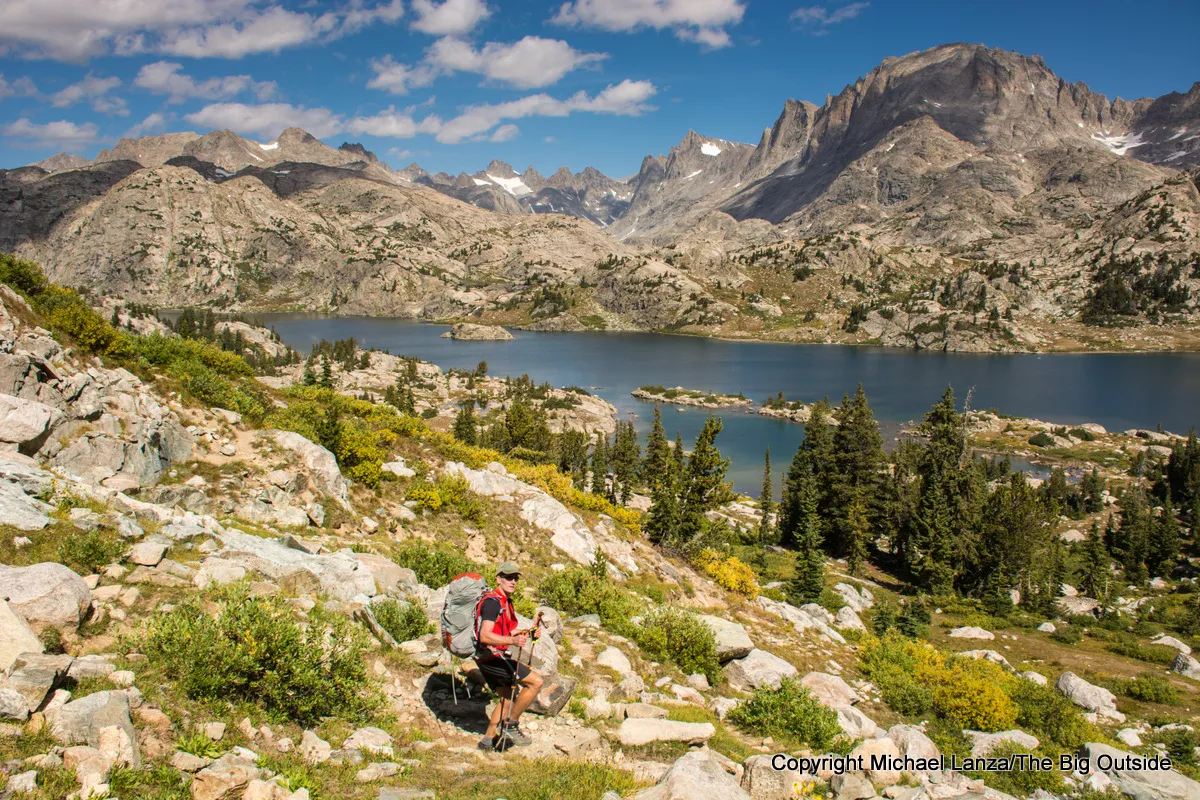 A backpacker hiking to Island Lake in WyomingApproaching Island Lake, a popular destination for Backpacking Wyoming Wind River Range.
A backpacker hiking to Island Lake in WyomingApproaching Island Lake, a popular destination for Backpacking Wyoming Wind River Range.
Seneca Lake-Highline-Doubletop Mountain Loop
This 42-mile loop, starting from Elkhart Park, does not receive the same level of attention as the Cirque of the Towers or Titcomb Basin. Instead, you will hike for miles primarily following less-traveled trails that still offer incredible views of the major peaks along the Continental Divide. You will also enjoy serene camps near beautiful lakes such as Island Lake, Elbow Lake, and many others. As is common with multi-day hikes in the Winds, you’ll pass multiple stunning lakes almost every day.
You can add a day to the trip with a layover for a dayhike into Titcomb and/or Indian basins, or choose to camp a night in either basin for a different perspective. Conversely, you can shorten the trip by a day by taking more direct trails from Summit Lake back to the trailhead. Located entirely on the west side of the Divide, this loop does not cross any high mountain pass. While at least one day involves significant elevation gain and loss and some steep sections, the majority of this route is not overly steep or strenuous, making it accessible for a wide range of abilities seeking to experience Backpacking Wyoming Wind River Range.
See two stories about trips that overlap parts of this route: “Best of the Wind River Range: Backpacking to Titcomb Basin” and “Backpacking Through a Lonely Corner of the Wind River Range.”
 A backpacker descending from Texas Pass into the Cirque of the Towers in the Wind River Range, Wyoming.Descending from Texas Pass offers a dramatic entry into the iconic Cirque of the Towers for those Backpacking Wyoming Wind River Range.
A backpacker descending from Texas Pass into the Cirque of the Towers in the Wind River Range, Wyoming.Descending from Texas Pass offers a dramatic entry into the iconic Cirque of the Towers for those Backpacking Wyoming Wind River Range.
Cirque of the Towers Loop
This loop represents a significantly shorter version of what I consider “the best backpacking trip in the Winds.” It bypasses the sections of that longer route that traverse Hailey and Washakie passes. This 30-mile loop begins at Big Sandy Campground, leads to Shadow Lake, involves the steep and physically demanding climb over Texas Pass, crosses the magnificent Cirque of the Towers to Jackass Pass, and finally descends towards Big Sandy Lake to complete the loop back to the trailhead.
For anyone seeking a loop hike that can be completed in two to four days, this is an excellent option. It’s even suitable for less-experienced backpackers and families provided they are prepared for the challenging ascent to Texas Pass. While this climb is quite steep and on loose scree, it gains only about 600 vertical feet and is not inherently dangerous if taken slowly and cautiously. This loop offers opportunities for pleasant lakeside camps every night and, perhaps not surprisingly, has become very popular. Experiencing the Cirque is a must-do when planning Backpacking Wyoming Wind River Range itineraries.
All of this loop is described in my story “The Best Backpacking Trip in the Wind River Range? Yup.”
See “5 Reasons You Must Backpack the Wind River Range,” “The Best Backpacking Trip in the Wind River Range? Yup,” “Backpacking Through a Lonely Corner of the Wind River Range,” “Best of the Wind River Range: Backpacking to Titcomb Basin,” “Adventure and Adversity on the Wind River High Route,” and “A Walk in the Winds: Dayhiking 27 Miles Across the Wind River Range,” and all stories about backpacking in the Winds at The Big Outside for more details on these incredible trips.
Frequently Asked Questions About Backpacking the Wind River Range
What is the best time of year for Backpacking Wyoming Wind River Range?
The ideal time for backpacking in the Wind River Range is typically mid-July through September. Early season (June to early July) can still have significant snow at higher elevations, making passes difficult or dangerous. Late season (October) brings colder temperatures and increased chances of snowstorms. August generally offers the most stable weather.
Are permits required for backpacking in the Wind River Range?
Permits are generally not required for standard overnight backpacking trips in the Wind River Range, which is primarily managed by the US Forest Service (Bridger-Teton and Shoshone National Forests). However, there are quotas and regulations in specific, highly popular areas, particularly around the Cirque of the Towers and Titcomb Basin during peak season. Always check the latest regulations with the relevant Forest Service district before your trip. Group size limits also apply.
What are the main hazards when Backpacking Wyoming Wind River Range?
Key hazards include rapidly changing alpine weather (thunderstorms, hail, snow even in summer), high elevation and potential for altitude sickness, crossing swift streams (especially earlier in the season), navigation challenges (especially off-trail or on less-maintained routes), and wildlife (bears, moose). Proper preparation for weather, carrying navigation tools, safe stream crossing techniques, and practicing Leave No Trace principles (especially proper food storage) are essential.
How difficult are the trails for Backpacking Wyoming Wind River Range?
Trail difficulty varies significantly. Many popular trails are well-maintained but involve substantial elevation gain and loss at high altitudes (above 10,000 feet). Some routes, like the Wind River High Route or those crossing passes like Texas Pass, involve off-trail travel, route finding, loose scree, and significant physical exertion. There are routes suitable for beginner backpackers, but most classic trips require at least moderate experience and fitness.
Is bear spray necessary in the Wind River Range?
Yes, carrying bear spray and knowing how to use it is highly recommended. The Wind River Range is home to both black bears and grizzly bears. Proper food storage (using bear canisters or hanging food properly) is also crucial to minimize encounters. Be bear aware at all times.
What kind of gear is needed for Backpacking Wyoming Wind River Range?
Due to the remote nature and high elevation, sturdy backpacking gear is essential. This includes reliable layers for varying temperatures, waterproof and windproof outer shell, sturdy hiking boots, a good quality tent capable of handling wind and potential snow, a warm sleeping bag rated for cold temperatures, navigation tools (map, compass, GPS/phone app), water filter/purifier, bear canister (often required in popular areas), and potentially an ice axe and microspikes if crossing passes early in the season. Proper gear is critical for a safe and enjoyable experience Backpacking Wyoming Wind River Range.
Plan Your Wind River Range Adventure
The Wind River Range offers a depth of wilderness experience that is hard to match. Whether you choose a challenging high route or a scenic loop through alpine lakes, the grandeur of the peaks and the profound sense of solitude will leave an indelible mark. It’s a destination that rewards preparation and effort with some of the most stunning mountain scenery in North America. Start planning your journey for Backpacking Wyoming Wind River Range today and discover this incredible landscape for yourself.
